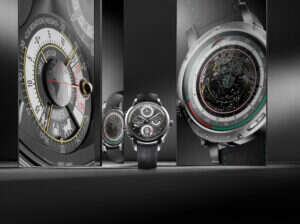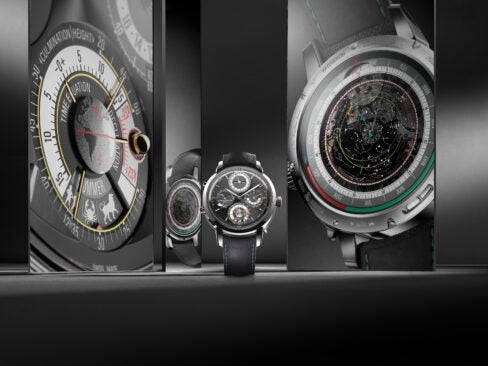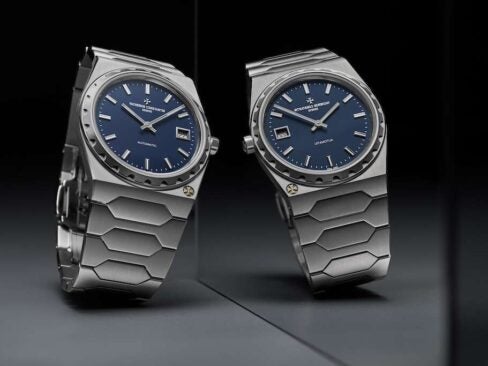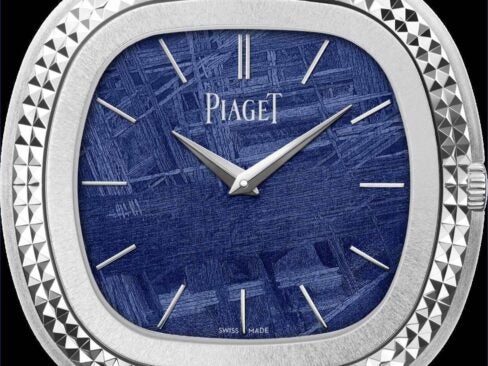
ANNUAL CALENDAR
Automatically accounting for the different lengths of each month, this type of watch usually displays the day, month and moon phase.
It only needs to be adjusted in February each year, correcting all other months automatically.
ANTI-REFLECTION
A film covering the sapphire crystal to eliminate light reflection, improving legibility.
Anti-reflection functions best when applied to both sides of the crystal, but because it scratches, some manufacturers prefer to place it only on the crystal’s interior. The dial on Zenith’s Chronomaster 1969 is a prime anti-reflection example.
AUTOMATIC WINDING
A rotating weight set into motion by moving the arm to wind a mechanical watch movement.
As long as the watch is moved, the kinetic energy will keep it wound indefinitely.
BALANCE
The beating heart of a mechanical watch movement is the balance: A tirelessly oscillating little wheel, just a few millimeters in diameter and possessing a spiral-shaped hairspring, sets the movement’s rhythm with its vibration frequency.
BEVELING
To uniformly file down the sharp edges of a plate, bridge or bar in the movement and give it a high polish.
Edges are usually beveled at a 45-degree angle.
BLUED SCREW

Polished steel screws are heated (tempered) to 290 degrees Celsius.
This process relaxes the steel, turning it a deep blue color. Only a few manufactures still temper with actual heat, others preferring the chemically induced version that assures an even color every time.
CALIBER
A term, similar to type or model, that refers to the specific name of a watch movement.
CARBON FIBER
A composite material made from carbon filament threads a mere one to two millimeters in diameter.
The filament itself comprises several thousand seven-micron carbon fibers held together by resin.
CERAMIC
An inorganic, nonmetallic high-tech material that is practically unscratchable.
It is generally used for cases and bezels and now comes in many colors.
CHRONOGRAPH
From the Greek chronos (time) and graphein (to write).
The earliest chronographs literally utilized ink or a pencil, and today this term continues to be used for watches that show not only the time of day, but also certain time intervals as if they were stopwatches on a strap. 21stcentury iterations include Roger Dubuis’s new Pulsion Chronograph, simultaneously sleek, sporty and sexy.
CHRONOMETER

As the term is used today, a chronometer denotes an especially accurate watch.
Chronometers are usually supplied with an official certificate from an independent testing office such as the C.O.S.C.
COMPLICATION
Any function of a watch additional to that of simple timekeeping, which conventionally encompasses the display of hours, minutes and seconds.
C.O.S.C.
Contrôle Officiel Suisse des Chronomètres, the official Swiss testing office for chronometers, is the world’s largest issuer of chronometer certificates, which are only otherwise given out individually by certain observatories.
For a fee, the C.O.S.C. tests and certifies the rates of movements.
CÔTES DE GENÈVE
Also called Geneva stripes, this is a traditional Swiss surface decoration for high-quality movement components that comprises an even pattern of parallel lines.
CROWN
Found on the case, it is used to wind and set a watch.
DECORATING/FINISHING

The traditional polishes and embellishments added to movement parts.
The better finished a movement is, the more expensive it will be.
ESCAPEMENT
A subgroup of the movement that divides the impulses coming from the spring barrel into small, accurately portioned doses.
It comprises the pallet fork, pallet lever, pallets and escape wheel.
FLYBACK CHRONOGRAPH
A chronograph developed for early aviation that can be started and stopped without first resetting.
Louis Vuitton’s new limited-edition Tambour Regatta America’s Cup Automatic (developed for the world of yacht racing) is a perfect modern example.
GMT
GMT, or Greenwich Mean Time, is based on the globe’s 24 time zone divisions as established in the Meridian Conference of 1884.
The Prime Meridian runs through the Royal Observatory in the London suburb of Greenwich. In contemporary watch parlance, GMT is often used to describe a wristwatch that displays a second time zone or a 24-hour indication. Glashütte Original’s new Grande Cosmopolite Tourbillon watch displays two time zones simultaneously, but ups the ante by allowing owners to select from all 37 of the world’s time zones, including those with 30- and 45-minute variations from GMT’s 24-zone system.
GUILLOCHE
A surface decoration usually applied to the dial and movement parts such as the rotor using a grooving tool with a sharp tip to cut an even pattern.
The patterns made by hand using a rose engine are very intricate and expensive to produce, which is why most dials decorated in this fashion are generally produced by stamping machines instead.
JEWEL

Tominimize friction in themovement, the hardened steel tips of amovement’s rotating gears are lodged in synthetic rubies fashioned as polished stones with holes and lubricated with a very thin layer of special oil.
LUMINOUS SUBSTANCE
Tritium is a slightly radioactive material used to coat hands, numerals and hour markers on watch dials, so they can be read in the dark.
Tritium has now for the most part been replaced by non-radioactive materials, such as Super-LumiNova, for medical reasons and expected governmental regulation of tritium’s use. A black background and luminous gold numerals make for an extremely easy-to-read dial on Panerai’s Luminor 1950 Tourbillon GMT Ceramica.
MANUFACTURE
Modern definitions of this word are not clear-cut, but most experts agree that the term should be used for a company that manufactures at least one caliber on its own premises.
Derived from Latin and meaning “made by hand,” horologists prefer this French variation.
MINUTE REPEATER
A striking mechanism with hammers and gongs for acoustically signaling the hours, quarter hours and minutes elapsed since noon or midnight.
Normally a repeater uses two different gongs to signal hours (low tone), quarter hours (high and low tones in succession) and minutes (high tone), as in Hublot’s King Power Cathedral Minute Repeater Tourbillon.
MOON PHASES
Usually found in a little cutaway on a watch dial, this indication provides information about the current status of the moon by use of a graphic representation like a golden disk.
Some brands, however, have been stepping outside the mold and delivering beautiful three-dimensional moon phase renditions, like Graff with its new GyroGraff timepiece.
MOVEMENT

The internal mechanism of a watch that drives its various functions, including timekeeping and complications like chronographs and perpetual calendars.
Movements can either be mechanical or quartz.
PERLAGE
Also known as circular graining, this is a surface decoration comprising an even pattern of partially overlapping dots applied with a quickly rotating plastic or wooden peg.
PERPETUAL CALENDAR
This type of calendar display automatically accounts for the different lengths of each month as well as leap years until the next secular year (in 2100).
A perpetual calendar usually displays the date, month and fouryear cycle and may show the day of the week (like Ulysse Nardin’s Blue Toro) and moon phase as well.
POWER RESERVE DISPLAY
A mechanical watch’s energy is provided by winding (manual winding) or rotor (automatic).
The power reserve display keeps the wearer informed about how much energy his or her watch still has in reserve, a function that is especially practical on manually wound watches with several days of possible reserve.
QUARTZ
Timekeeping’s technical revolution found its way to the world’s wrists in the late 1970s.
The first working quartz wristwatches were manufactured by an early joint venture within the Swiss watch industry, but Japanese firms—primarily Seiko—came to dominate the market with the new technology. The quartz movement uses the vibration frequency of a quartz crystal subjected to electronic tension (usually 32,768 Hz) as its norm.
RATE
The daily rate is the term a watchmaker uses to describe the accuracy of a particular movement measured in seconds.
The average daily rate is a mean value measured over several days.
RETROGRADE DISPLAY
A retrograde display shows the time linearly instead of circularly.
The hand continues along an arc until it reaches the end of its scale, at which point it jumps instantaneously back to the beginning.
ROTOR
The rotor is the component that keeps an automatic watch wound.
Its kinetic motion, created by the motion of a moving wrist, winds the mainspring.
SAPPHIRE CRYSTAL
Synthetic sapphire crystal has become the material of choice to protect the dials of modern wristwatches.
This material, known to gemologists as aluminum oxide (AI2O3) or corundum, is virtually scratchproof with a hardness of nine on the Mohs scale. Only a diamond is harder.
SILICIUM/ SILICON
Silicon, the most common element on earth after oxygen, is relatively new to the watchmaking industry and is thus often described as a “new material.”
Many companies prefer to call it by its Latin name, silicium. It is currently being used in the manufacture of escapements and other precision parts, replacing the materials traditionally used such as steel and brass.
SKELETONIZATION

The technique of cutting a movement’s components down to their weightbearing basic substance.
This is generally done by hand in painstaking hours of microscopic work with a mini handheld saw, though machines can skeletonize parts to a certain degree.
SPLIT-SECOND CHRONOGRAPH
Also known in the watch industry by its French name, the rattrapante, this is a chronograph with two second hands, one of which can be stopped to indicate an intermediate time while the other continues to run.
When released, the split-second hand “catches up” to the position of the other second hand.
TOURBILLON
Patented by Abraham-Louis Breguet in 1801, it compensates for the influence of gravity on the escapement.
From the French word for “whirlwind,” the entire escapement is mounted on an epicyclic train in a “cage” and rotated completely on its axis over regular periods of time, usually once a minute. So beautiful is this complication that it is not uncommon for watchmakers to make it visible through the dial, as with the new Tondo Tourbillon Gioiello for ladies from de Grisogono.
VIBRATION FREQUENCY (VPH)
The frequency of the balance’s alternating vibrations is measured in Hertz (Hz) or vibrations per hour (vph), which is also sometimes written as A/h, the “A” standing for the French alternance (change).
Most of today’s wristwatches tick at frequencies of 28,800 vph (4 Hz) or 21,600 vph (3 Hz). Less common, but still found in certain models, are vibration frequencies of 18,000 vph (2.5 Hz) and 36,000 vph (5 Hz).
WATER RESISTANCE
Water resistance is an important feature of any timepiece and is usually measured in increments of one atmosphere (ATM or bar, equal to ten meters of water pressure) or meters and is often noted on the dial or case back.
Breitling’s Superocean 42 White Water is water resistant up to an astounding 1,500 meters (5,000 feet).









